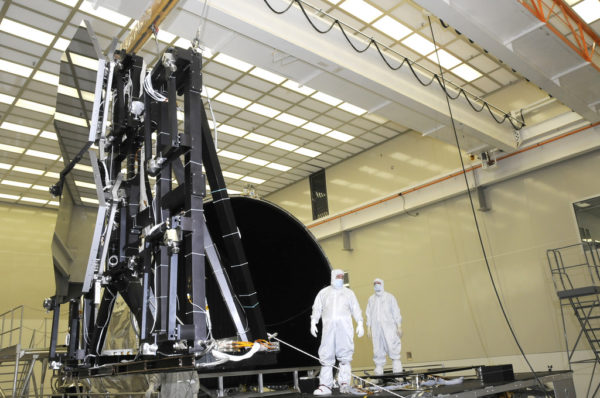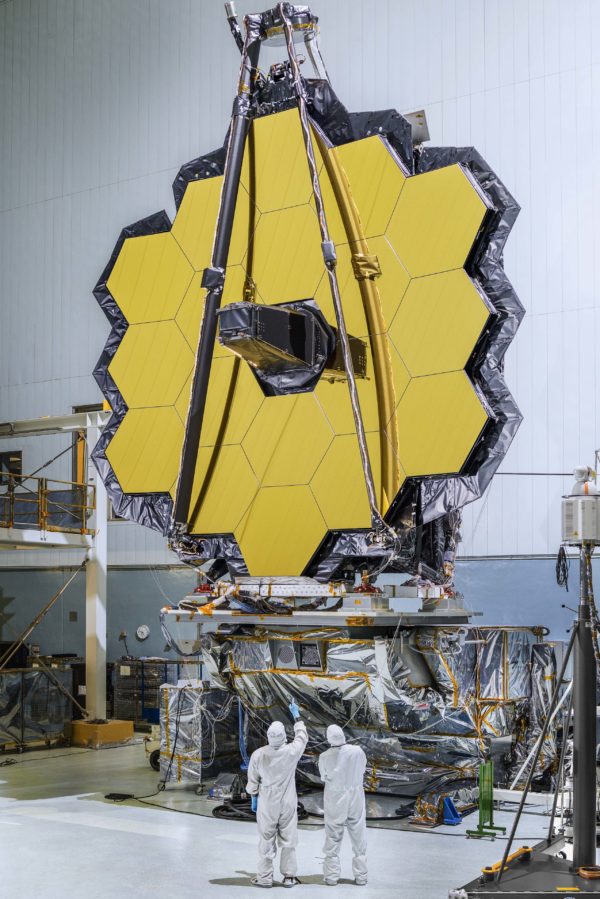"Hey, if our eyes could access the infrared part of the light spectrum, the sky would be green and trees would be red. Some animals see in completely different ways, so who knows what colors look like to them. Nothing is really how we perceive it." -Wendy Mass
If you take a look at the James Webb Space Telescope, the most visually striking feature of all is the gold mirrors. Yet gold would make an absolutely terrible material for constructing these mirrors! For very sound scientific reasons, the vast majority of these mirrors are made out of beryllium, not gold, and gold doesn't even enter the equation until after the first and second polishings.
 Only after being machined, polished, cooled, re-polished and thoroughly tested will the gold coating be applied over the beryllium mirror. Image credit: Ball Aerospace.
Only after being machined, polished, cooled, re-polished and thoroughly tested will the gold coating be applied over the beryllium mirror. Image credit: Ball Aerospace.
But gold is a fantastic material for reflecting infrared light, and so getting a uniformly thick gold coating on these mirrors in imperative. When all is said and done, a surface area of 25 square meters -- the equivalent of 269 square feet -- must be coated in this thin gold coating, which itself must be protected from the environment.
 The 18 segments of James Webb in the laboratory, after completed assembly and all coatings have been applied. The gold is visually striking, but there's very little of it. Image credit: NASA / Chris Gunn.
The 18 segments of James Webb in the laboratory, after completed assembly and all coatings have been applied. The gold is visually striking, but there's very little of it. Image credit: NASA / Chris Gunn.
How much gold does this take? The scientific story of the mirrors holds the answer!
- Log in to post comments

I put together some ideas for space telescopes of future if anyone interested:
http://fb36blog.blogspot.com/2017/04/ultimate-space-telescope.html
The JWST doesn't need much gold, just lots of money.
Essentially the same process we use for creating earthbound telescope mirrors. Figuring the mirror holder (Pyrex in the old days), after the grinding & polishing stages,would take several nights to achieve, allowing the night temperatures to cool the glass to operating conditions. After a figuring session, it would be the next night before one could test the figure. Surprising how much heat can be generated while polishing any irregular zones. It is possible to get a figure down to a 40th of a wavelenght of coherent light. Of course, in a catadioptric system, that figure is absolutely necessary for an overall 1/10 wavelength error. (4 surfaces of the cat)
When done, send it off to the Uni for vacuum deposition of Al, overcoating, etc. Aaah, the good old days.
Probably not. The odd thing is that colour doesn’t really have any physical reality, and it’s all in our minds. That stupid blue/black/white/gold dress that made the rounds a while back is an illustration of this. We tend to think of certain wavelengths of light producing certain colours, but if you mix green (495-570 nm) and red (620-740 nm) light we see yellow. Did the mixing of colours cause the light we see to change wavelengths? No. The mixed light excites the M and L cones in our retinas equally, which the brain then interprets as yellow, the same as light in the 570-585 nm wavelength range would. There are even “imaginary colours” that cannot possibly be produced by any physical source of light. The eye has three different types of cones, the S, M, and L cones, and their sensitivities to the various wavelengths of light overlap. No physical source of visible light can excite only, say, the M cones: any such source will excite the M or L cones or both as well to some degree. If you could, perhaps by direct neural stimulation, excite only the M cones, then one would presumably perceive that as a very intense shade of green. Much of what we think of as colour and our language for colour is dependent on the way our visual system is structured. If we had different visual system that had access to the infrared spectrum, we’d probably have a different language for these colours which reflected this.
Sorry to have gotten so far out of topic, but the physics of colour might make for a good future article.
But I for one consider building a bridge to the edge of the universe a better use of money than unconstitutional domestic espionage or bombing brown people, or many other bridges to nowhere that have lately gotten a lot more funding.
Wow! This thing is going even way beyond the Moon orbiting the Sun. Great article!
To really answer the title question I assume there is more gold than that to make the whole thing? In electronic components, cable connectors etc. Would that accumulate to an equal amount to what is on the mirrors?